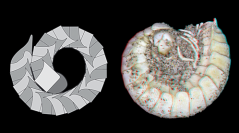

 Comptes Rendus Palevol
22 (29) - Pages 595-604
Comptes Rendus Palevol
22 (29) - Pages 595-604Millipedes have a long evolutionary history, with the oldest presumed fossils of Diplopoda de Blainville in Gervais, 1844 being from the Silurian and the first definite fossil record originating from Devonian deposits. The phylogeny of Diplopoda is not fully resolved yet, especially not concerning fossil representatives. At the same time, already in the Palaeozoic millipedes showed quite a morphological and presumably also ecological variety. We describe here a new species of a Carboniferous millipede from the Westphalian A of the Netherlands, Lauravolsella willemeni n. gen., n. sp., a possible representative of Archipolypoda (†Archipolypoda Scudder, 1882). The species is based on a single specimen, preserved with part and counterpart, which both show a three-dimensional preservation. The specimen has unusually long tergites, in normal life position covering most of the following segment. These long tergites might have been beneficial when performing defensive enrolling. In extant millipedes, enrolling is usually facilitated by softer areas between the sternites, allowing for a certain degree of ventral compression. In the new fossil, the sclerotic sternites occupy the entire length of the ventral side of the segment, not allowing for any type of compression. The new fossil therefore demonstrates another solution for the mechanical challenges during enrolment and increases the morphological diversity of Carboniferous millipedes.
Myriapoda, Diplopoda, Archipolypoda, stereo imaging, new genus, new species.